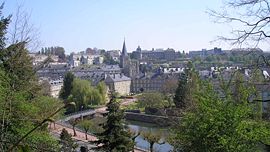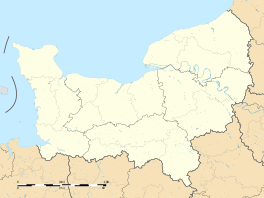Vire
| Vire | ||
|---|---|---|

Vire from the Place du Château
|
||
|
||
| Coordinates: 48°50′N 0°53′W / 48.84°N 0.89°WCoordinates: 48°50′N 0°53′W / 48.84°N 0.89°W | ||
| Country | France | |
| Region | Normandy | |
| Department | Calvados | |
| Arrondissement | Vire | |
| Canton | Vire | |
| Government | ||
| • Mayor (2008–2014) | Jean-Yves Cousin | |
| Area1 | 22.50 km2 (8.69 sq mi) | |
| Population (2008)2 | 12,231 | |
| • Density | 540/km2 (1,400/sq mi) | |
| Time zone | CET (UTC+1) | |
| • Summer (DST) | CEST (UTC+2) | |
| INSEE/Postal code | 14762 /14500 | |
| Elevation | 85–225 m (279–738 ft) (avg. 134 m or 440 ft) |
|
|
1 French Land Register data, which excludes lakes, ponds, glaciers > 1 km² (0.386 sq mi or 247 acres) and river estuaries. 2Population without double counting: residents of multiple communes (e.g., students and military personnel) only counted once. |
||
1 French Land Register data, which excludes lakes, ponds, glaciers > 1 km² (0.386 sq mi or 247 acres) and river estuaries.
Vire (French: [viʁ]) is a town and a former commune in the Calvados department in the Normandy region in northwestern France. On 1 January 2016, it was merged into the new commune of Vire-Normandie.
The town is located on the river Vire.
In 1123, Henri I Beauclerc, King of England and Duke of Normandy, had a redoubt constructed on a rocky hill top, which was surrounded by the Vire river. The redoubt was stoned square at the bottom to assure the defense of the Duchy of Normandy against any attacks from Brittany or Maine.
This stone work would be later, At the beginning of the 13th century, Saint Louisordered that the existing stonework be supplemented with exterior ramparts. However this second precinct was only finished at the beginning of the 14th century.
In the old community of Neuville, north of the territory, the castle of Tracy is the seat of an important manor, Arcisse de Caumont.
At the end of the Middle Ages, the village prospered; first with leather, and then with textiles During the hundred years war, Vire was plundered in 1368 by large military companies, and delivered to the English in 1418. The English occupation would end in 1450 and would be brutal to the inhabitants. The execution of Hugues Vaux, owner of the largest farm of the village, after refusing to give up his farm to the English sergeant Fields, caused grief and concern amongst the population. Some inhabitants nevertheless benefited from the English occupation. Eugène Vergny, who provided Fields with information about the movement of the French troops, received the property of Vaux after his execution.
...
Wikipedia



